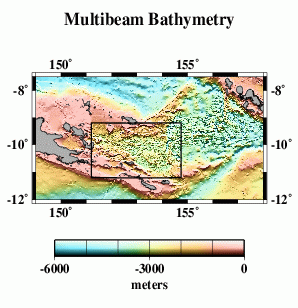Multibeam Swath Bathymetry - Woodlark Basin
Geophysical Analysis
Data
Grid Information:
- West = 151.2
- East = 154.75
- South = -11.2
- North = -9.2
- Grid Nodes: nx = 4501, ny = 2251
- Depth: Max = 3412 m, Min = -5999 m
GMT command line arguments:
- -R151.2/154.75/-11.2/-9.2
- -I.002
Grid Files:
- .CDF (masked), (GZ, 34.81 MB)
Data Source:
- This grid was provided to us by Brian Taylor, Andrew Goodliffe, and Fernando Martinez, School of Ocean and Earth Science and Technology, University of Hawaii.
- References:
- Goodliffe, A., B. Taylor, and F. Martinez, 1999, Data Report:Marine geophysical surveys of the Woodlark Basin region, in Taylor, B., P. Huchon, A. Klaus et al., Proc. ODP, Init. Repts., 180, Ocean Drilling Program, College Station, TX, 1-20 [CD-ROM].
- Goodliffe, A., B. Taylor, F. Martinez, R. Hey, K. Maeda, and K. Ohno, 1997, Synchronous reorientation of the Woodlark Basin spreading center, Earth Planet. Sci. Letts., 146, 233-242. DOI: DOI: 10.1016/S0012-821X(96)00227-0
- Martinez, F., B. Taylor, and A. M. Goodliffe, 1999, Contrasting styles of seafloor spreading in the Woodlark Basin: Indications of rift-induced secondary mantle convection, J. Geophys. Res., 104, 12,909-12,926. DOI: 10.1029/1999JB900068
- Taylor, B., A. Goodliffe and F. Martinez, 1999, How continents break up: Insights from Papua New Guinea, J. Geophys. Res., 104, 7,497-7,512. DOI: 10.1029/1998JB900115
- Taylor, B., A. Goodliffe, F. Martinez, and R. Hey, 1995, Continental rifting and initial seafloor spreading in the Woodlark Basin, Nature, 374, 534-537. DOI: 10.1038/374534a0
Profile Comparisons
Here we compare profiles from swath bathymetry (A) with estimated bathymetry (B), and satellite-derived gravity anomalies (C). Because there are limited constrainted points (black dots in E) in the estimated bathymetry along the profile (red line), and because of the resolution limit of the altimeter data used in the bathymetry prediction, the estimated anomalies do not resolve short- wavelength seafloor features evident in swath bathymetry (F).
| A | 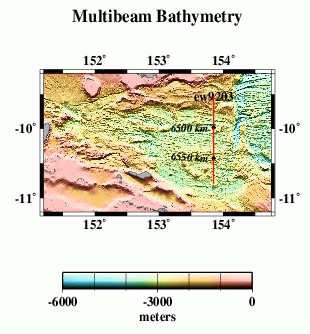 |
B | 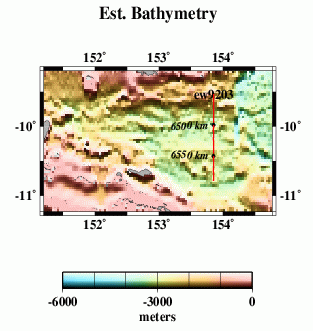 |
C | 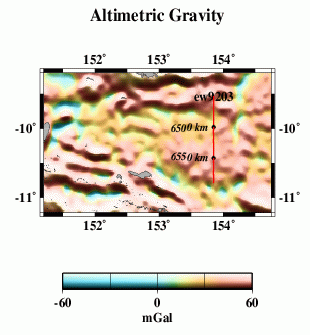 |
|---|
| D | 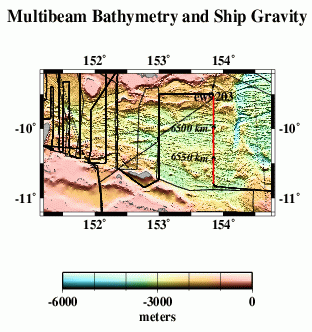 |
E | 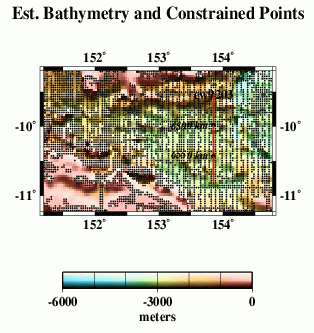 |
|---|
| F | 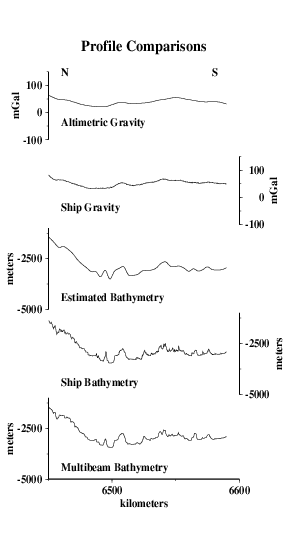 |
|---|
Grid Analysis
We compare the difference between altimetry-estimated bathymetry (2 min. grid) and actual swath bathymetry (.002 deg. grid) two ways, because the two are on grids of different spacing and thus may capture different length scales of bathymetric roughness.
For the lower-resolution analysis (G and H), multibeam data were averaged into corresponding 2-arc-minute blocks, and estimated bathymetry was subtracted. For the higher-resolution analysis (I and J), bilinear interpolation was used to obtain estimated bathymetry values at each point on the swath bathymetry grid, then the estimated bathymetry was subtracted.
In both cases, we find the mean difference is ~ 53 m (the swath bathymetry data are systematically deeper); the difference is about 2.6% of the depth. An error like this is expected because of the uncertainties in whether or not data sets used in calibration have been corrected for the variable speed of sound in seawater, errors translating uncorrected sound speeds between nominal fathoms and nominal meters, etc.
The standard deviations about the mean are 215 m for the 2 arcmin averages and 220 m for the multibeam points. Since 220² - 215² ~= 47², We may assume that the root-mean-square (rms) average rounghness captured by the multibeam and not capturable on a 2 arcmin grid is about 47 m. The rms difference at longer scales, 215 m, is due to incomplete information in the estimated bathymetry grid.
| G | 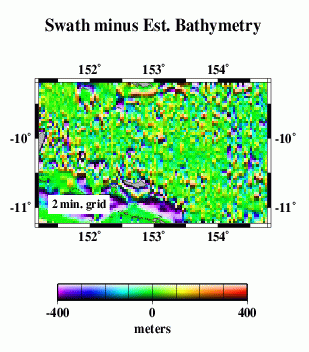 |
H | 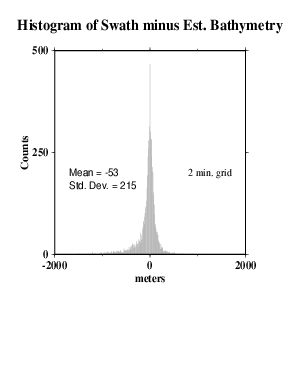 |
|---|
| I | 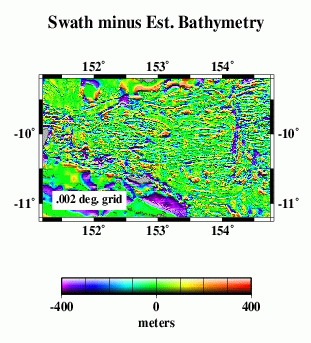 |
J | 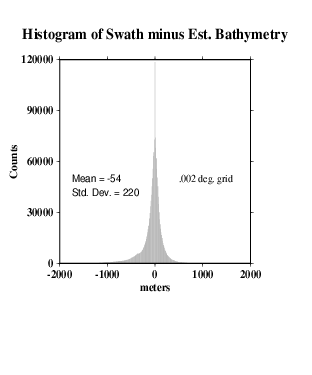 |
|---|
Eventually, we want to do a detailed cross-spectral analysis to determine how much of the actual multibeam bathymetry is captured in the altimeter gravity field. Here, we present a very simplified model. We take the multibeam bathymetry (A) and simply calculate a model gravity field, assuming that all the topography has the same density and is entirely uncompensated. This model (L) does not look much like the observed gravity (K), because our assumptions are too simple, and because of isostatic compensation reflected in the observed gravity anomalies.
The radially-averaged power spectra of the two (M) show the simple gravity model has more power at most wavelengths. At wavelengths greater than ~100 km or so, this is due to the effects of isostatic compensation of the topography that is not taken into account in the model. At shorter wavelengths the model also has more power than the altimetric gravity. Some of this is due to smoothing in the altimeter data necessary to remove noise. We don't know whether the simple model is realistic at these wavelengths. We need high quality ship gravity data to compare.
| K | 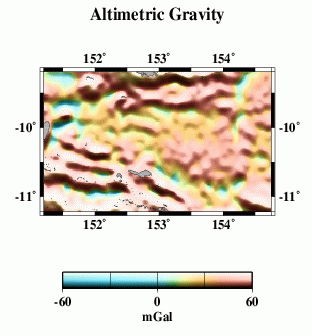 |
L | 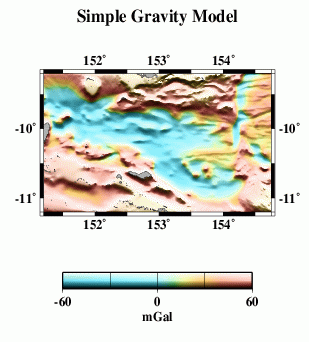 |
M | 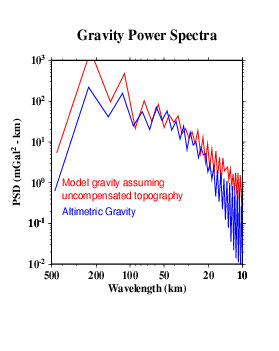 |
|---|

